Grandfather Golf & Country Club
NC, USA
Green Keeper: Pete Gerdon

Only on the rare occasion does architecture, both golf and otherwise, transcend the time from which it was born. In general, it reflects the mood of the time. For instance, it is no coincidence that the Golden Age of golf course design occurred during the roaring 1920s when people’s spirits were high. Those flamboyant times were best captured by option-filled courses built on a large scale with fifty yard wide plus fairways and boldly contoured greens.
However, the Great Depression and World War II put Americans in a distinctly different frame of mind. People became more serious minded and frugal. In general, inspiring architecture suffered to the point where no one confuses the 1950s and 1960s as the zenith of great architecture of any form. Relating to golf, those architects that did the best work were invariably the ones that worked and learned under one of the master architects from the 1920s. Examples include Robert Trent Jones with Stanley Thompson and Dick Wilson under William Flynn. Another such one is the influence that Donald Ross had on the Maples family of North Carolina.
The patriarch of the Maples family, Frank, worked side by side with Ross as the head superintendent of Pinehurst Country Club for over forty years. His son Ellis Maples was born in 1909 and learned much about growing grass and golf course architecture from watching his dad and Mr. Ross. By the early 1930s, Ellis Maples made a name for himself at Pine Needles and Mid-Pines for his ability to both grow grass as well as his playing skills. Unfortunately, not only did his generation have to contend with the effects of World War I and the Great Depression but also World War II during which time Ellis Maples served with honor as an agronomist. After the war, Ellis Maples supervised the construction of Raleigh Country Club for Ross and stayed there for five years in the dual capacity as head golf professional and greenkeeper. Alas, this was Ross’s last design as he died in 1948 (Frank passed away the very next year) and to learn more about Ross’s influence on Maples, please click here.
From these times scarred by war and tough economic times emerged a well rounded and kind gentleman. Skilled at all key positions from golf course superintendent to golf professional to construction supervisor, Ellis Maples decided to establish his own golf architecture firm from which he could draw on all three talents. By the early 1960s, the Maples name and Ellis Maples‘s own reputation helped him secure several high profile projects. One was the Pinehurst Number Five in 1961 with Richard Tufts and another was the Dogwood Course at Country Club of North Carolina in 1963, which quickly received glowing accolades from several national publications.
Given his background in the sandhills of North Carolina, one might logically assume that Ellis Maples‘s masterpiece would have been built there. Ironically, his architectural masterwork came in the exact opposite climate which is to say the low humidity but rocky environs found 4,000 feet above sea-level in the Linville River Valley in the mountains of North Carolina.
When studying an architect’s body of work, if one course is a particular stand-out, it is frequently telling to learn more about the person behind the project and what that founding vision was. An architect unshackled from the usual development constraints is by definition free to shine and show the world of what he is truly capable. The man who set the stage for Ellis Maples and that allowed Grandfather Mountain Golf & Country Club to transcend the period in which it was born was actually a woman, Agnes (Aggie) MacRae Morton Cocke Woodruff. Starting in 1889 when the MacRae family purchased 15,750 acres, they promoted the health benefits found in this glorious valley. As one component of that, they helped develop the Eseeola Lodge in Linville and the famous Donald Ross course attached to it. These proved very popular as a summer and fall retreat especially bearing in mind that Carolinians needed to head either to the shore or the mountains to get out of the stifling summer heat (remember: air-conditioning did not exist on a widespread basis until after World War II).
When Linville Golf Club became a prisoner of its own success and tee times were scarce by the mid 1960s, Aggie decided to establish her own course where she and friends could enjoy a quiet game at their leisure. Her part of the family land was nearly 2,000 acres and was located approximately two miles north of Linville. As for who would design the course, she knew exactly where to turn: Donald Ross’s protege Ellis Maples based in Whispering Pines, North Carolina 230 miles away.
Not unlike Marion Hollins at Cypress Point, Aggie had strong views as to what constituted great golf. She of course wanted no two holes to play alike but she also wanted total separation from one hole to the next. Importantly, she was a great equestrian and having ridden around her property for decades she knew it better than anyone and that played an instrumental role in helping Maples line up certain playing corridors against some of the most impressive spires and backdrops.
To Maples’s lasting credit, he delivered on all her demands including having the holes play in separate corridors. This is no small ask as if the landforms are interesting in one direction, they are frequently good for a parallel hole running in the opposite manner. Yet Maples fulfilled her request for separation while still making the course easily walkable as the holes flow seamlessly from one to another with short green to tee walks being the norm. This makes Grandfather better than just a collection of eighteen holes, given how well the holes work with each other.
Though its idyllic setting makes it impossible to, the golfer needs to put on the same game face he would have when playing Pine Valley. There are no weak holes at Grandfather and with the low-lying rhododendrons and other lush mountain vegetation just off some of the fairways, the golfer never wins by trying to overpower the course. Rather, placement and prudent course management are greater allies than reaching for the driver and brute strength as we see in the Holes to Note below.
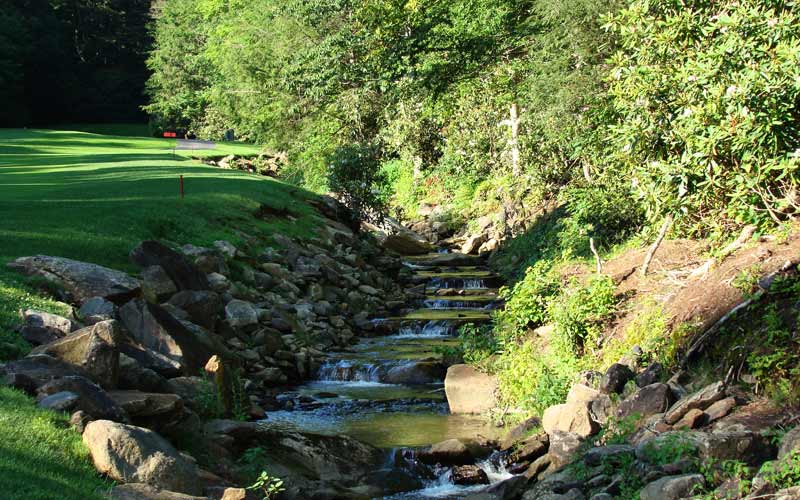
Following Donald Ross’s old adage of giving the golfer a gentle handshake start, Maples has Grandfather commence with a modest length par five followed by one of the three sub 400 yard par fours on the course. The golfer who has driven a few hours to get here appreciates Maples’ gesture of allowing him to edge into his game. Starting at the elevated third green which has been the scene of manya putt leaving the green, the golfer goes an invigorating run of holes that are unique unto themselves and that remind the golfer of no others.
Holes to Note
(Author’s note: Grandfather enjoys two predominate playing seasons, namely the summer when the rest of the Carolinasare sweltering and the fall when it is ablaze in color. Photographs from each season are included below.)
Fourth hole, 455/430 yards; Despite there being several captivating views from elevated tees, Maples managed to build only two holes that require distinctly uphill tee balls.This is the first, with the tenth being the other one. He accomplished this by building several uphill walks from green to tee, most notably in the four green to tee walks commencing after the eighth green. Here at the fourth, a high fade is ideal on this dogleg to the right and once to the crest of the hill, the golfer is greeted with a thrilling view of the open green well below.

Fifth hole, 210/200 yards; A wonderfully naturally mountain hole, all made by Maples’ great routing. The hole plays from the high side of the river valley across the stream to the green on the other side with a tall bank of trees serving as the attractive backdrop. Maples knew when to leave well enough alone and avoided extraneous clutter. However, the nice touch here is how the green’s front left to back right angle perfectly complements the other one shotter on the front (the ninth) whose green runs in the opposite manner (i.e. front right to back left, calling for a draw). As an excellent golfer himself, no doubt Maples appreciated the design requirement to make the good golfer shape balls either way.

Sixth hole, 570/535 yards; Routing a mountain course is guaranteed to be slow going as trees and boulders abound along with thick vegetation. How architects are able to spot holes and then connect them is certainly an art form unto itself. In the case of the sixth, one imagines Maples’ attention being caught by the stream and his desire to introduce the hazard to the course in earnest here for the first time. After all, five holes into the round and the golfer should be properly loose and prepared to face stiffer challenges. The reverse ‘S’ nature of the stream made it perfect for golf and Ellis Maples captured its attributes brilliantly. The golfer first needs to carry it off the tee and then again on his second shot as the stream crosses the fairway 200 yards from the green on a diagonal and then hugs the right of the fairway. The green itself is deep but narrow so the golfer likes to approach it from head on. With the stream lurking right, a not unexpected number of approach shots are played from the left rough.

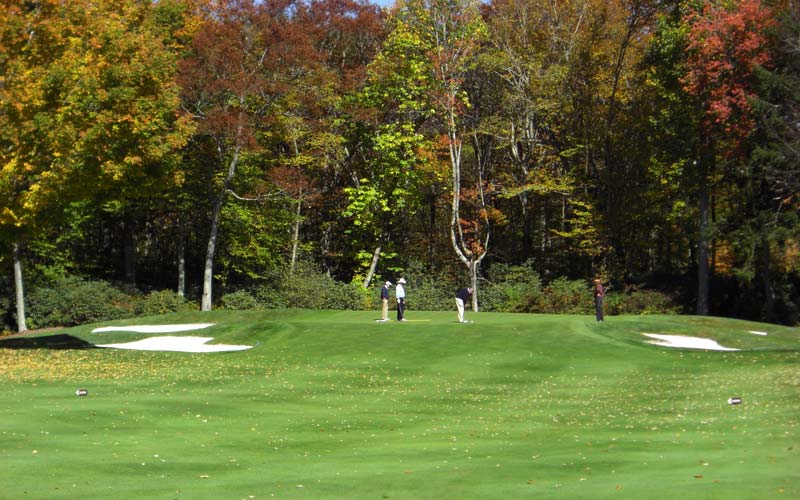
Seventh hole, 430/385 yards; This is a prime example of how Aggie’s intimate knowledge of the property was put to great use. From the get-go, she wanted a hole to line up with Dunvagan Peak. From the design perspective, Maples wisely didn’t do anything from tee to green to distract the eye. However, as the second photograph below shows, the built-up green pad has fine golfing qualities as a variety of recovery shots are called for depending on where one misses it (e.g. swale left and around, sand right and short grass for approach shots that are missed short and straight).
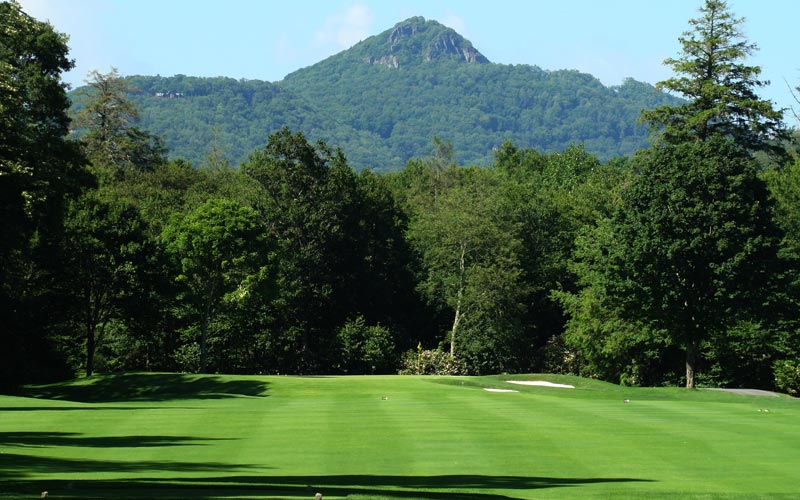

Eighth hole, 375/355 yards; On a course that measures over 7,100 yards from the back, the first time visitor may delight when he comes to this, the shortest par four on the course. Unfortunately, its modest distance is more than made up forby its elevated green which falls five feet (!) fromback to front. Given the low humidity and the perfect environment for growing bent grass, Green Keeper Pete Gerdon always has the greens playing fast and firm. A six foot putt from above certain hole location is far worse/more taxing than a twenty foot putt from below. The exacting nature in keeping one’s approach below the day’s hole location makes this a placement hole of the highest calibre. Those that get out of position need to appreciate that the punishment fits the crime on this short par four.
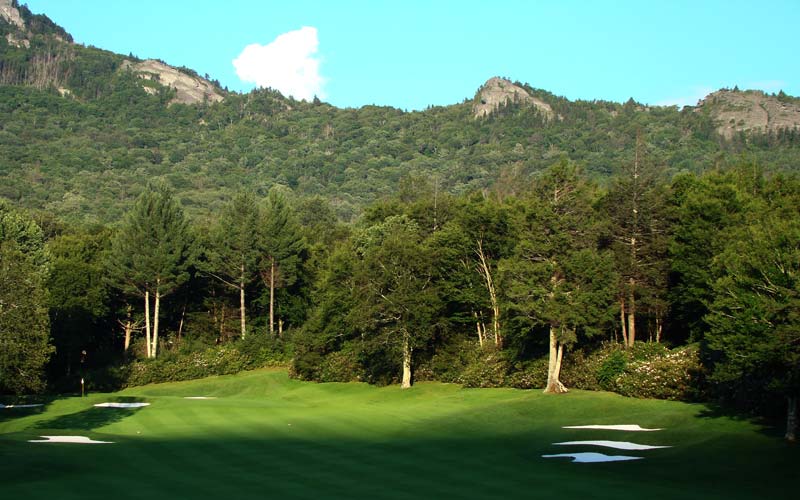

Ninthhole, 210/200 yards; The notion of hitting a ball to spot ‘x’ in order for it to take a slope and finish over by ‘y’ is one of golf course architecture’s most time-honored design themes. Of the numerous examples of such architecture, perhaps the Redan is the most famous. Though there is no Redan in Pinehurst, Maples was clearly comfortable with its concept when he built this hole. In this version, the pond is the hole’s most formidable hazard but the surrounding short grass and Maples’ use of the right to left slope of the land give the golfer ample room to work the ball in from the right.

Tenth hole, 400/380 yards; This is only hole on the course that is markedly uphill on both the first and second shots. That speaks well of the routing in the context of how the holes always change and flow/fall over the ground in varying ways. As at the eighth though, the fact that the green is the high point of the hole spells trouble. Indeed, apart from the glories of its mountain setting, the aspect of Grandfather that comes up the most in conversation are its treacherous greens. Everyone knows that they follow the slope of their surrounds. Nonetheless, their tilt (either back to front or side to side as here at the tenth) combined with today’s green speeds makes them be considered among the most two or three challenging set to putt in the state.
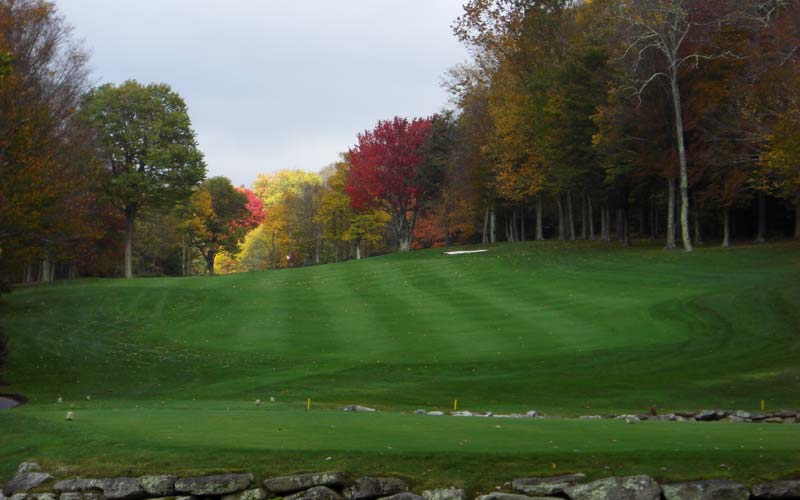
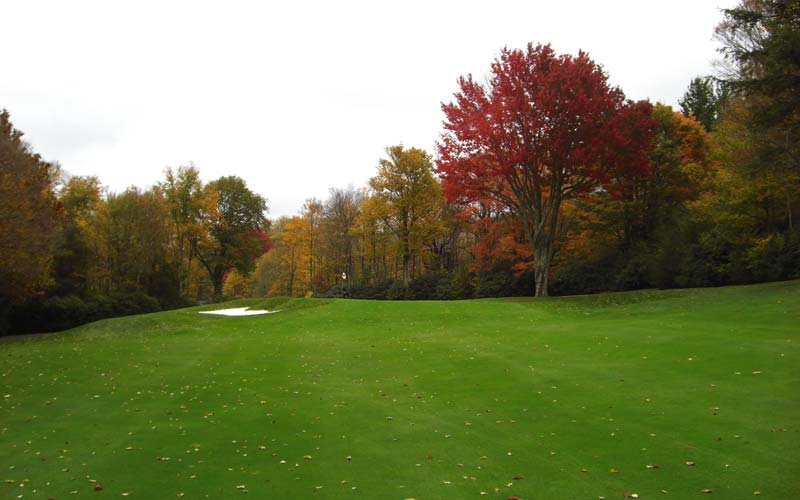
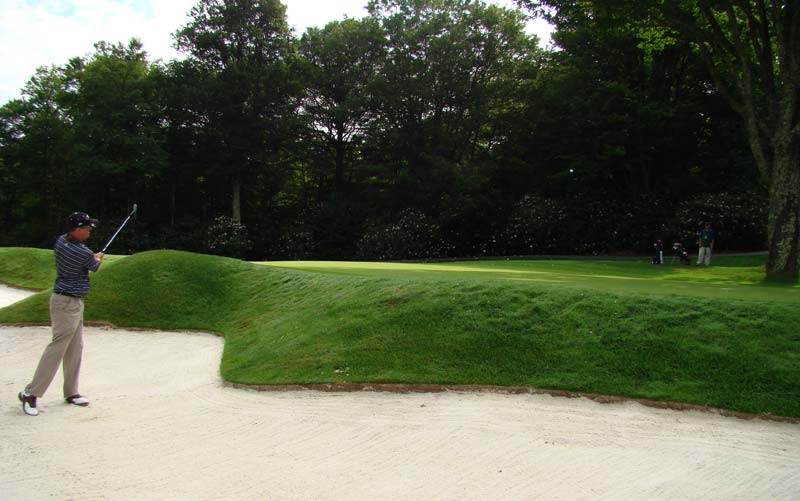
Eleventh hole, 510/490 yards; Though the rigors of a game at Grandfather are evident by now, good golf design always involves give and take on the part of the architect. Here, Maples gives the golfer hope of reaching the green in two if he can hit a good drive well down the fairway. Otherwise, a stream sixty yards shy of the green forces a lay-up.

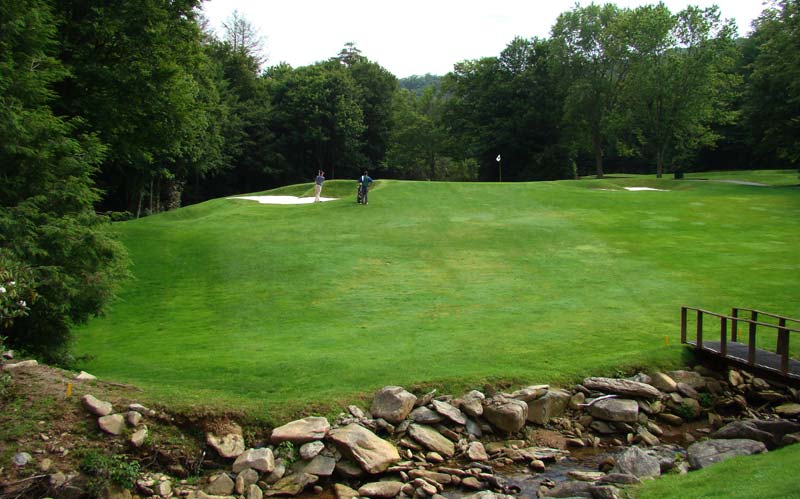
Grandfather Golf & Country Club
NC, USA
Thirteenth hole, 420/405 yards; As Maples mulled over various routing options, this must have been one of the holes that he was always determined to include; the fact that a par three precedes and follows it hints as to how he used those holes as connector holes to preserve this one. There wasn’t much that needed to be done other than to create an area for the tees and clear the woods below and voila (!), a hole of majestic beauty of the sort that makes mountain golf so endearing. The exhilaration of seeing a tee ball soaring off into the distance and watching it fall forever against the pristine backdrop of trees is one with which few courses can compete.

From the elevated tee, the golfer soaks in the striking view of the thirteenth hole well below. The lone hemlock on the right encourages approaches from the left.
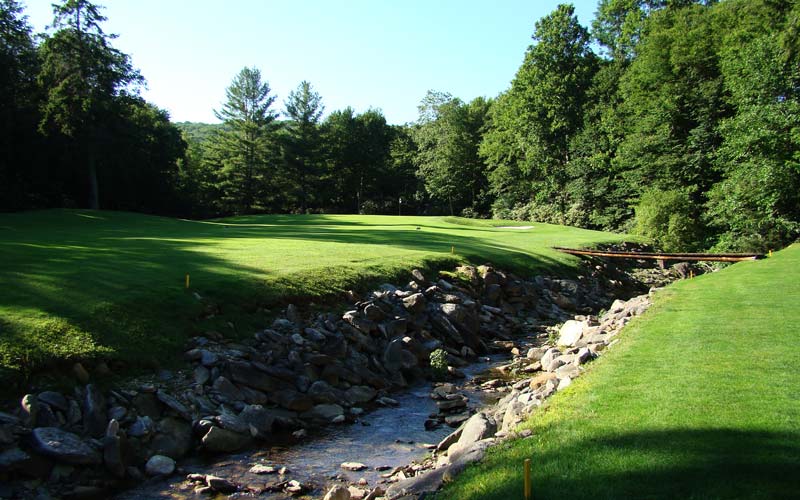
Once down in the fairway, the hole is relatively level but clearing this stream is problematic if one’s drive didn’t find the fairway.

This view back up the thirteenth shows the extent to which the tee box is elevated. As is usually the case, the elevated tee makes the fairway appear a tighter target than it actually is.
Fourteenth hole, 160 yards; Too much of a good thing is a trap that has ensnared many a modern architect. As it became increasingly easy to move dirt and even to build streams and waterfalls, architects (and the owners whom pushed them) built more and more ‘postcard’ holes into each course. At some point, the golfer’s senses can’t absorb any more. If individual holes continually compete among themselves for attention, the golfer sadly might even become numb to the whole proceedings, which is certainly the opposite from what the architect hoped to achieve. Coming off from the course’s most spectacular hole, Maples had a choice to make at the fourteenth as to just how much to throw visually at the golfer. In a show of welcome restraint, he elected not to incorporate the stream into the hole’s aesthetics. Instead, standing on the tee, the golfer sees a fairly ordinary uphill one shotter. First impressions are wrong though as the green narrows to only nine paces wide in the rear and the sloping terrain left of the green brings the hidden creek into play. Unlike the thirteenth where all its hazards/challenges are in plain view, the golfer might not appreciate the challenges here until it’s too late.
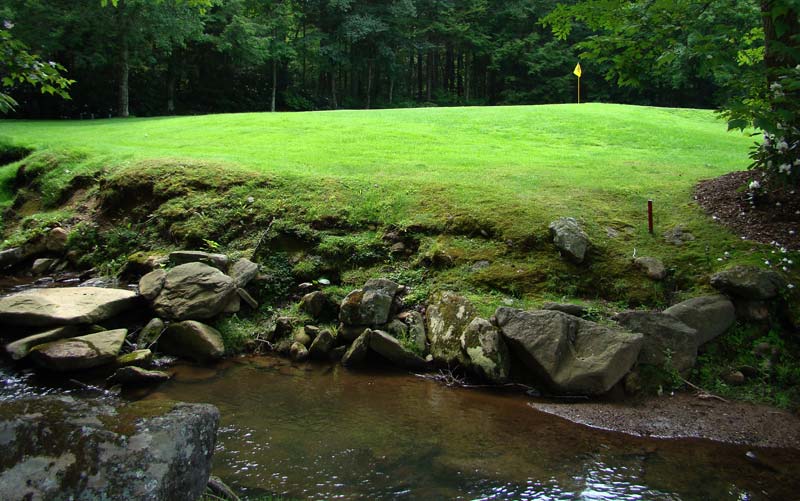
Completely hidden from view from the tee, the green’s shoulder has kicked many a pulled tee ball into this stream left of the fourteenth green.
Fifteenth hole, 390 yards; Longtime golf professional Bob Kletche considered this his favorite hole on the course. Though it is bunkerless and under 400 yards, the fifteenth offers plenty of challenge. A creek left and woods right define the tee shot but it is the domed green that most frustrates the golfer. Unlike courses built in the 1970s and 80s that employed confrontational hazards close to the green edge, Maples again displayed the good sense to focus on the variety of the challenge (i.e. a bunkerless green unique to the course that shrugs balls away on all sides) rather than repeating water as the primary hazard.

The creek is more of a hazard off the tee than it is up by the green where it never gets within fifteen yards of the putting surface.
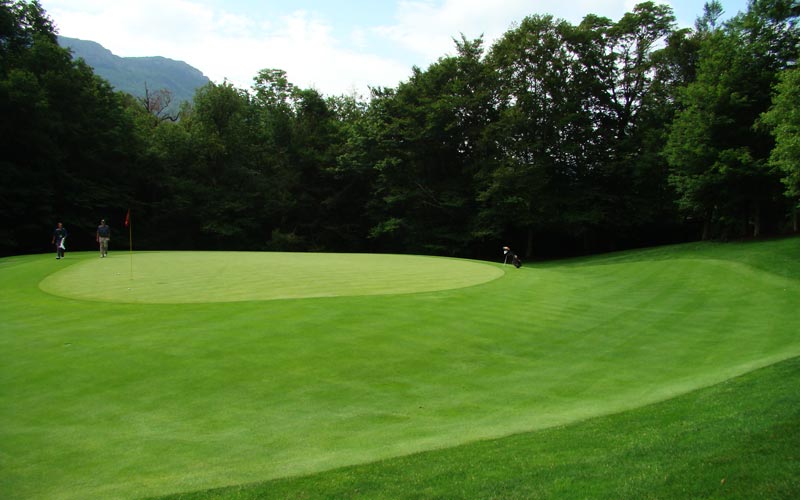
The crowned green and short grass chipping area remind many of Maples’ Pinehurst roots.
Sixteenth hole, 450/420 yards; Adding to the diversity of the course’s overall challenge are the two sloping fairways that come next, both here and the penultimate hole. In this case, the hole is a sharp dogleg right and the further to the outside of the dogleg the golfer plays, the more below his feet the ball is for his approach shot. This fade stance is especially troublesome as a lone pine thirty yards from the green on the left blocks such a shaped shot. The ideal tee ball hugs the inside of the dogleg, leaving the golfer a relatively level stance into one of the course’s most difficult greens that feeds away toward the back right.
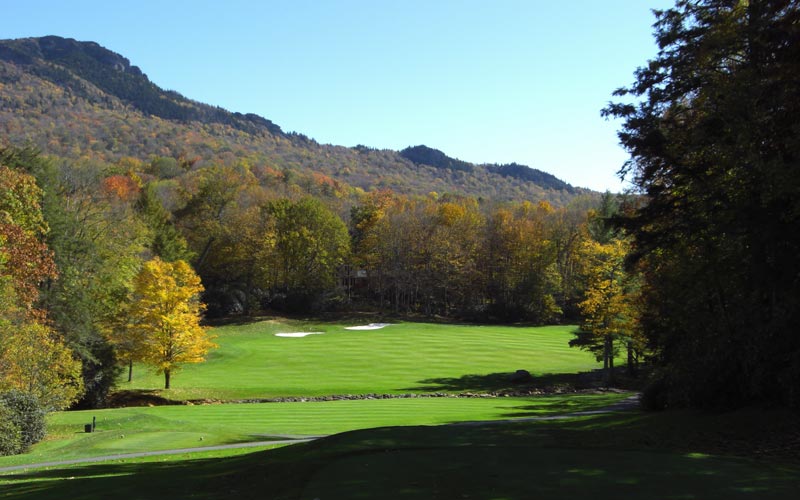
The sixteenth fairway swings sharply right with trees and a stream protecting the inside of the dogleg. The only relatively flat spot on the fairway is on the inside of the dogleg (i.e. near the trouble). Tee balls played safely toward the bunkers on the outside of the dogleg leave a hanging lie.

In addition to the hanging lie, the tall pine tree thirty yards short of the green on the left makes approach shots problematic when played from the outside of the dogleg.
Seventeenth hole, 585/565 yards; This hole fits the classic definition of a great par five in that each shot gets progressively more difficult. The reverse ‘S’ use of the creek is reminiscent of the sixth hole but the golfer is now given a hook stance for his second shot as the ball is likely to be above his feet. Regardless of the stance, the golfer feels compelled to advance the ball another 200 plus yards on his second shot given both the length of the hole and the shallow nature of the green. Though wide, the green at only twenty-one paces in depth is the exact opposite to the deep but narrow one at the sixth and it puts an emphasis on having but a short iron into it.
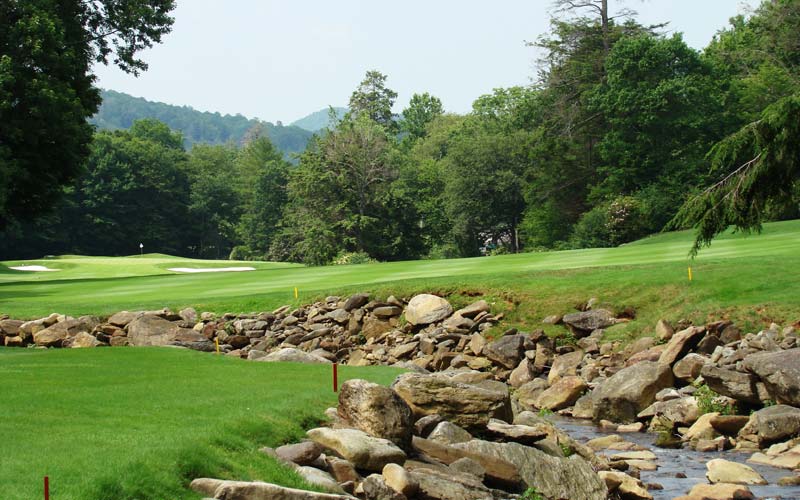
This photograph some 200 yards forward of the tee shows the stream that must be carried with the drive and more importantly, the sharp right to left tilt of the fairway in the landing area.

As at the sixth, once safely in the landing area off the tee, the stream must be carried again on one’s second while avoiding it along the right with one’s lay-up.
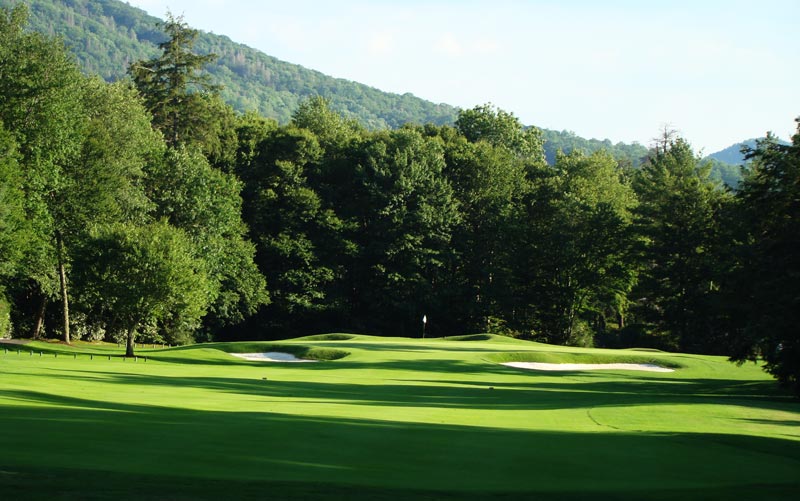
The shallow but wide seventeenth green mimics the slope of Grandfather Mountain in the background in that it slopes pronouncedly from left to right.
Eighteenth hole, 415/400 yards; More than one member selects this as their favorite hole on the course, which is quite a statement given the choices. Most impressively, especially considering when this course was built, this Home hole embodies the strategic design philosophy. Much of the 1960s saw penal architectural as the general rule with a course like Pine Tree demanding aerial golf to elevated greens with bunkers flush against the putting surface. Here, allowances were cleverly built into the green surrounds to allow a ball to take the left to right slope and feed down the length of the green, all without ever having to cross the natural water hazard that trails down the right of the hole. The fact that a family of four different generations of golfers can equally enjoy this closing hole highlights one of the reasons why Grandfather has remained so popular with many of the same families for its first forty years.

The view down the eighteenth fairway is toward the clubhouse before the hole…
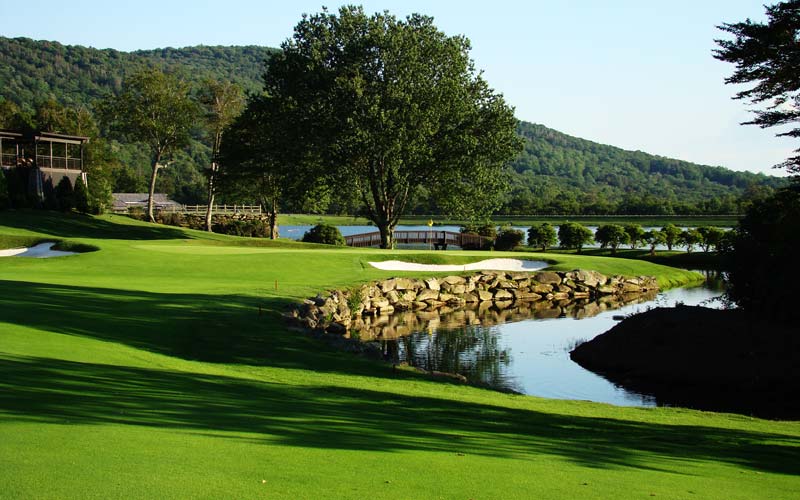
…moves to the right at the green which juts into Loch Dornie. No need to fly a ball at the back hole location seen above; far better to use the green’s left to right tilt to feed the ball toward such hole locations.
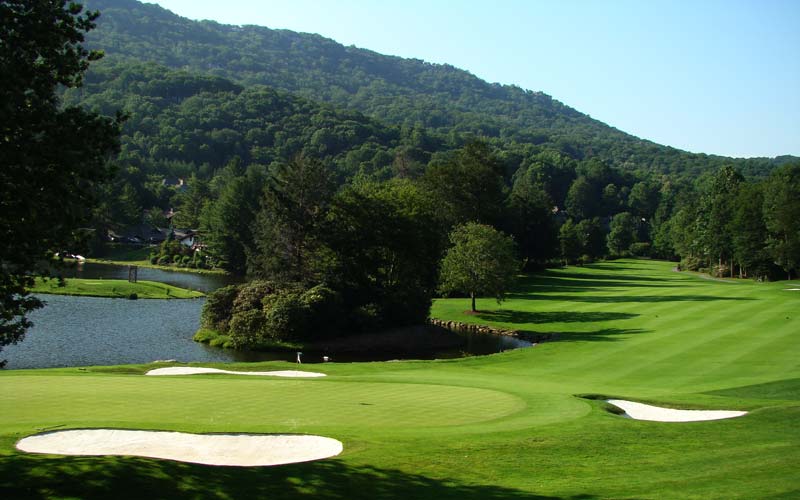
The view from the clubhouse balcony back down the eighteenth shows how the hole can be played all the way along the short grass as opposed to ever flying a ball over the water hazard.
Grandfather demands it all from the golfer, from accurate drives to a deft touch around/on the greens. Bunkers aren’t the primary hazard with which the golfer must contend; that distinction goes to the features found in mountains such as streams and the vegetation found at this altitude. Yet, Grandfather’s challenge is still a fun one, helped enormously by its inspired mountain setting and how Maples’ routing made the most of it. Though it was built in the 1960s, the principles behind the club are timeless of enjoying the great outdoors and providing a place for families to gather.
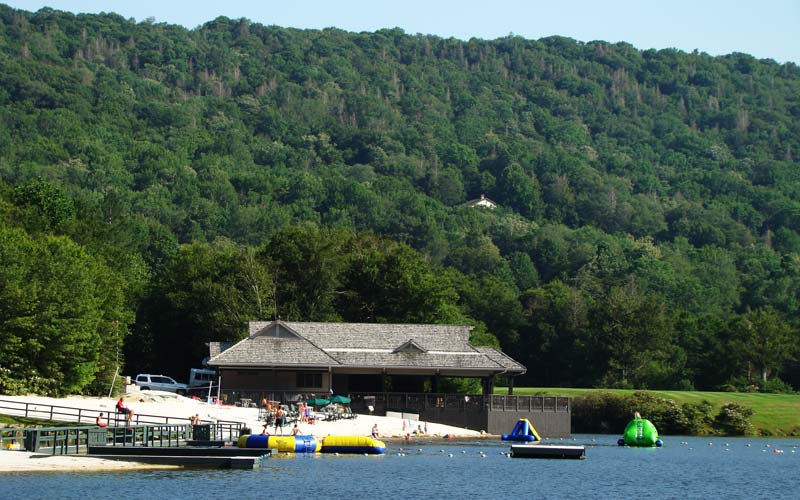
The Beach Pavilion at Grandfather is but one example of the club’s commitment to family and to enjoying the health benefits of being outdoors.
Ellis Maples wrote a letter to the club on September 15th, 1965 that read in part,
The magnificent scenery afforded by the west slope of Grandfather Mountain as it towers above the Linville River Valley where Glen Dornie is located I feel provides a golf course setting that is unequalled in North Carolina. Tremendous trees line the fairways and the lake, streams and topography afford opportunities for a great variety of interesting golf holes.
For once, an architect didn’t embellish and even more impressive is how he delivered on the final product. When Aggie sees what Grandfather means today to so many people, she is bound to appreciate that her desires have been fully met.
The End





![The Park, West Palm (Lit 9) [2023]](https://golfclubatlas.com/wp-content/uploads/2024/12/IMG_7092-2-scaled-500x383.jpg)


